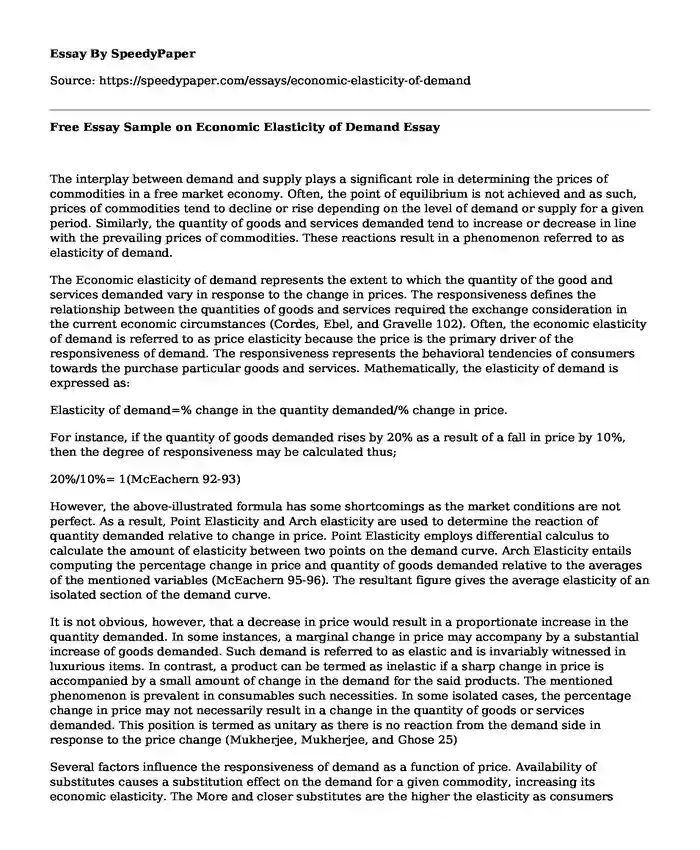
| Type of paper: | Essay |
| Categories: | Microeconomics |
| Pages: | 3 |
| Wordcount: | 679 words |
The interplay between demand and supply plays a significant role in determining the prices of commodities in a free market economy. Often, the point of equilibrium is not achieved and as such, prices of commodities tend to decline or rise depending on the level of demand or supply for a given period. Similarly, the quantity of goods and services demanded tend to increase or decrease in line with the prevailing prices of commodities. These reactions result in a phenomenon referred to as elasticity of demand.
The Economic elasticity of demand represents the extent to which the quantity of the good and services demanded vary in response to the change in prices. The responsiveness defines the relationship between the quantities of goods and services required the exchange consideration in the current economic circumstances (Cordes, Ebel, and Gravelle 102). Often, the economic elasticity of demand is referred to as price elasticity because the price is the primary driver of the responsiveness of demand. The responsiveness represents the behavioral tendencies of consumers towards the purchase particular goods and services. Mathematically, the elasticity of demand is expressed as:
Elasticity of demand=% change in the quantity demanded/% change in price.
For instance, if the quantity of goods demanded rises by 20% as a result of a fall in price by 10%, then the degree of responsiveness may be calculated thus;
20%/10%= 1(McEachern 92-93)
However, the above-illustrated formula has some shortcomings as the market conditions are not perfect. As a result, Point Elasticity and Arch elasticity are used to determine the reaction of quantity demanded relative to change in price. Point Elasticity employs differential calculus to calculate the amount of elasticity between two points on the demand curve. Arch Elasticity entails computing the percentage change in price and quantity of goods demanded relative to the averages of the mentioned variables (McEachern 95-96). The resultant figure gives the average elasticity of an isolated section of the demand curve.
It is not obvious, however, that a decrease in price would result in a proportionate increase in the quantity demanded. In some instances, a marginal change in price may accompany by a substantial increase of goods demanded. Such demand is referred to as elastic and is invariably witnessed in luxurious items. In contrast, a product can be termed as inelastic if a sharp change in price is accompanied by a small amount of change in the demand for the said products. The mentioned phenomenon is prevalent in consumables such necessities. In some isolated cases, the percentage change in price may not necessarily result in a change in the quantity of goods or services demanded. This position is termed as unitary as there is no reaction from the demand side in response to the price change (Mukherjee, Mukherjee, and Ghose 25)
Several factors influence the responsiveness of demand as a function of price. Availability of substitutes causes a substitution effect on the demand for a given commodity, increasing its economic elasticity. The More and closer substitutes are the higher the elasticity as consumers easily switch from one commodity to another with the slightest change in price. Moreover, consumers would buy goods or seek a certain service regardless of the price changes if the purchase if necessity. For instance, a customer would not switch from buying drugs for a person with long-term health conditions. Consumers also tend to switch from a product if the change in price represents a significant portion of their incomes. If the change in price represents a small effect on incomes of the consumers, the elasticity of demand for the good or service is marginally low (McEachern 99-100)
The concept of economic elasticity of demand is used in the business circles to make pricing decisions. Notably, goods and services with high elasticity experience minimal price adjustments from the industry players.
Works Cited
Cordes, Joseph J, Robert D. Ebel, and Jane Gravelle. The Encyclopedia of Taxation & Tax Policy. Washington: Urban Institute Press, 2005. Print.
McEachern, William A. Macroeconomics: A Contemporary Introduction. Cincinnati: South-Western College Pub, 2016. Print.
Mukherjee, Sampat, Mallinath Mukherjee, and Amitava Ghose. Microeconomics. New Delhi: Prentice-Hall of India, 2007. Print.
Cite this page
Free Essay Sample on Economic Elasticity of Demand. (2019, Aug 29). Retrieved from https://speedypaper.com/essays/economic-elasticity-of-demand
Request Removal
If you are the original author of this essay and no longer wish to have it published on the SpeedyPaper website, please click below to request its removal:
- Free Essay Containing a TOEFL Waiver Request Letter Sample
- Political Science Essay: Current Events and U.S Diplomacy
- Free Essay on Reduction of Air Pollution Using Bio Fuels as Form of Renewable Energy
- Free Essay Sample on Karl Marx and His Theories
- Essay Example: Can the President Pardon Himself?
- Prescription Drug Misuse Free Essay
- Free Essay. Civil Peace Analysis
Popular categories




